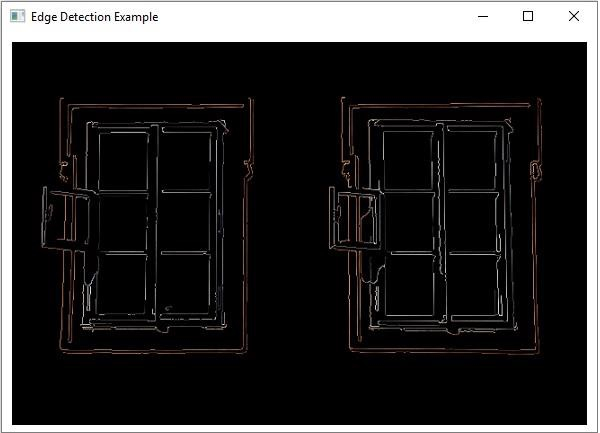
 Data Structure
Data Structure Networking
Networking RDBMS
RDBMS Operating System
Operating System Java
Java MS Excel
MS Excel iOS
iOS HTML
HTML CSS
CSS Android
Android Python
Python C Programming
C Programming C++
C++ C#
C# MongoDB
MongoDB MySQL
MySQL Javascript
Javascript PHP
PHP
- Selected Reading
- UPSC IAS Exams Notes
- Developer's Best Practices
- Questions and Answers
- Effective Resume Writing
- HR Interview Questions
- Computer Glossary
- Who is Who
Java example demonstrating canny edge detection in OpenCV.
The canny edge detector is known as optimal detector since it detects only the existing edges, gives only one response per page and minimizes the distance between the edge pixels and detected pixels.
The Canny() method of the Imgproc class applies the canny edge detection algorithm on the given image. this method accepts −
Two Mat objects representing the source and destination images.
Two double variables to hold the threshold values.
To detect the edges of a given image using the canny edge detector −
Read the contents of the source image using the imread() method of the Imgcodecs class.
Convert it into a gray scale image using the cvtColor() method of the Imgproc class.
Blur the resultant (gray) image using the blur() method of the Imgproc class with kernel value 3.
Apply canny edge detection algorithm on the blurred image using the canny() method of the Imgproc.
Create an empty matrix with all values as 0.
Add the detected edges to it using the copyTo() method of the Mat class.
Example
import java.awt.Image;
import java.awt.image.BufferedImage;
import java.io.IOException;
import javafx.application.Application;
import javafx.embed.swing.SwingFXUtils;
import javafx.scene.Group;
import javafx.scene.Scene;
import javafx.scene.image.ImageView;
import javafx.scene.image.WritableImage;
import javafx.stage.Stage;
import org.opencv.core.Core;
import org.opencv.core.Mat;
import org.opencv.core.Scalar;
import org.opencv.core.Size;
import org.opencv.highgui.HighGui;
import org.opencv.imgcodecs.Imgcodecs;
import org.opencv.imgproc.Imgproc;
public class EdgeDetection extends Application {
public void start(Stage stage) throws IOException {
//Loading the OpenCV core library
System.loadLibrary( Core.NATIVE_LIBRARY_NAME );
String file ="D:\Images\win2.jpg";
Mat src = Imgcodecs.imread(file);
//Creating an empty matrices to store edges, source, destination
Mat gray = new Mat(src.rows(), src.cols(), src.type());
Mat edges = new Mat(src.rows(), src.cols(), src.type());
Mat dst = new Mat(src.rows(), src.cols(), src.type(), new Scalar(0));
//Converting the image to Gray
Imgproc.cvtColor(src, gray, Imgproc.COLOR_RGB2GRAY);
//Blurring the image
Imgproc.blur(gray, edges, new Size(3, 3));
//Detecting the edges
Imgproc.Canny(edges, edges, 100, 100*3);
//Copying the detected edges to the destination matrix
src.copyTo(dst, edges);
//Converting matrix to JavaFX writable image
Image img = HighGui.toBufferedImage(dst);
WritableImage writableImage= SwingFXUtils.toFXImage((BufferedImage) img, null);
//Setting the image view
ImageView imageView = new ImageView(writableImage);
imageView.setX(10);
imageView.setY(10);
imageView.setFitWidth(575);
imageView.setPreserveRatio(true);
//Setting the Scene object
Group root = new Group(imageView);
Scene scene = new Scene(root, 595, 400);
stage.setTitle("Gaussian Blur Example");
stage.setScene(scene);
stage.show();
}
public static void main(String args[]) {
launch(args);
}
}
Input Image

Output
On executing, the above produces the following output −


